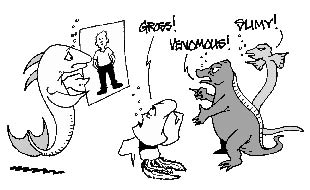1.2(a) Who Gets Heard?
Aim
To explore attitudes to those who are considered different or outsiders from the group, who gets heard and how to include each other.
You need
Flipchart paper and a load of post-its or other labels and at least an hour.
What to do
The game and discussion in this activity aim to help the group explore attitudes and prejudice. These are
difficult but important areas to explore. There should be no need to put anyone on the spot, but do check
everyone is okay and take time out if necessary to take the heat out of any misunderstandings or strongly
held differences. Let’s start with a game that raises important points, but is quite light hearted.

a) Take it in turns to call out the name of an animal. Or you could draw the animal and hold it up. Everyone then calls out what his or her reaction to it is. Some examples you could choose are kitten, vulture, wolf, butterfly, slug, elephant, snake, scorpion, dolphin, worm. Write up or draw on flipchart the words people call out. Or you could put them on labels. Are some nice and others nasty? Do you all agree? How easy is it to generalise about each of these creatures? Does everyone agree with these generalisations?
b) Now this gets harder. Looking at those words on the flipchart or labels, are there any of the animals or terms to describe them that you have heard used against different groups of people? Ring or underline these. We describe people, for example, as sharks, vultures, snakes. Some of your labels might include cuddly, scrounger, mean, delicate, gross, fat, venomous, spiteful, wonderful, slimy.
c) What do you think are the labels and stereotypes used towards those interested in tackling climate change? Why are they given? When people think about climate change a few words come to mind such as ‘hippy’ and ‘green.’ Think about what that means for you and the audience you are attracting?
What do you think?
Who gets labelled? Does your group? Why? What’s good and what’s bad about it? What can we do about it? Discuss these issues in the group. You can develop these ideas by cutting out a range of images of people from magazines and newspapers. Spread them around the floor or on the table. Who do you see? Who don’t you see? For example, if there are pictures of young people, what are they doing? Are they positive pictures, or are they showing young people as getting into trouble or being a nuisance? Are there pictures of black lawyers or politicians? Are there pictures of disabled sports men and women? Are there pictures of women in the army?
What next?
Often youth clubs and schools and the work place develop equal opportunity statements and policies to make sure everyone is treated fairly and equally, with respect for people’s differences, perhaps due to gender, race, culture, religion, disability and sexuality. They are often based on the simple, but very hard to put into practice, motto that goes ‘Treat others as you would want others to treat you’. Does your group have a charter or statement about respecting and valuing people? If you do, look at it again and see if you want to update it. Does it, for example, say how you will welcome new members and support those who might have particular needs? If you don’t have a charter, it is well worth the time creating one. Make sure everyone in the group understands it and that it can be clearly seen where you meet. Make sure new members know of it and know it is taken seriously. YouthBank UK’s Golden Rules, for example, have guided its development and growth over ten yers, ensuring change has always been rooted in its shared values and core purpose. The group may also want to draw up its own more detailed agreement about how it works, often called a constitution. There is a range of resources to help with this. Look out for How to be a community champion by Michael Norton. Details are in the where to find out more section of Act by Right.
